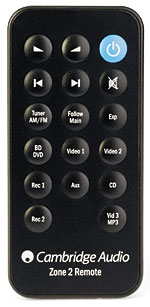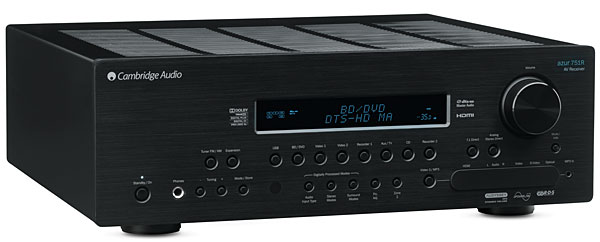Cambridge Audio Azur 751R A/V Receiver Page 2
 On a Feeling Level
On a Feeling Level
A high-end receiver changes the way I listen. When I start demos, I operate on a feeling level. The first thing I want to know is how loud I can play the receiver before it hurts my ears. With a run-ofthe-mill receiver, distortion rises quickly with volume. That turns into a stop sign, and I cut volume to reduce listening fatigue, tailoring my listening to the receiver’s shortcomings. With the Azur 751R, I pushed the volume higher and higher, marveling at how much power the receiver could pump into the speakers before clipping set in. But even clean sound, in sufficient amounts, can pin my ears back. Because the receiver changed the way I listened on a feeling level, I needed more time to determine average cruising altitude. Once I found that, hearing movies and music through this receiver became even more of a pleasure. It performed cleanly across the frequency spectrum with especially generous bass weight. Content
with significant high-frequency information was as airy as it could be but without undue brightness. The midrange included a well-sculpted presence region that delivered loads of texture without inducing discomfort. Everything sounded right.
Perfect Sense is an unorthodox drama about a civilization literally losing its senses, one by one. Vocal reproduction was highly natural, with enunciation neither over- or underplayed. While the score’s sorrowing violin and echoey piano were soundtrack clichés, they still sounded smooth and rich, adding to their emotional effect. A brief interlude of wraparound rain demonstrated how well the system could handle subtle surround effects.
Machine Gun Preacher dramatizes the life and work of Sam Childers, who traded a life of crime for spiritual awakening and a child rescue mission in the Sudan. Gerard Butler delivers one of the most intense performances I’ve ever seen by a male in a leading role. The action-rich soundtrack was aggressive enough to benefit from the Audyssey listening-mode treatment, with Dynamic EQ on (to prevent dialogue and surround effects from disappearing at lower volume levels) and Dynamic Volume set to the midpoint of its three settings (to reduce dynamic range to something less confrontational).
In Haywire, director Steven Soderbergh takes a stab at mixed martial arts, setting action star Gina Carano into motion, and supplementing her minimal gravitas with supporting players like Michael Douglas, Ewan McGregor, Michael Fassbender, and Antonio Banderas. What diverted me as much as the onscreen talent was the cool, quizzical, stylish spy-film score. My notes remind me how much I liked the electric guitar and keyboards. Also the bass and drums. Also the cymbals and brass—you get the idea. The fact that every instrument grabbed my attention suggested the presence of a well-rounded performer in the rack’s guest-receiver berth.
 Electrified
Electrified
Much of Richard Thompson’s Electric CD celebrates a power trio in which bassist Taras Prodaniuk and longtime drummer Michael Jerome back up the bandleader’s electric guitar arsenal, including his familiar dancing Fender Strat. Recorded in analog and mixed with the usual digital software, the Buddy Miller production
had a spacious and warm sound, though too-rigorous compression marred some instruments on some tracks, especially the drums. Surprisingly, it was Thompson’s voice that came through
most consistently with powerful you-are-there (or maybe he-is-there) imaging. The album reached its emotional high point on its least electric track, “The Snow Goose,” a stark dreamscape populated only by Thompson’s Lowden acoustic and his bleak baritone. Any receiver would make this superbly ungimmicky track sound good, but the Azur made
it spellbinding.
It was on this album that I switched Audyssey 2EQ on and off with repeated dives into the GUI. As usually happens with decent room correction, the equalized version was tighter and better imaged, especially in the prominent lead vocal, though its textures were thinner and more austere. Turning off 2EQ blurred imaging but also achieved a richer and more palatable tonal balance. The longer I listened to the unequalized version, the more natural the voice sounded, as my brain somehow repaired the imaging defects of the uncorrected room.
Two Against Nature is one of a handful of Steely Dan albums available in a 5.1-channel mix. If you don’t like horn charts in the surrounds, you’re free to select the DVD-Audio release’s high-res stereo soundtrack. I opted for the full treatment this time. The Audyssey room correction played to this album’s strengths—its almost military pinpoint precision—especially in Donald Fagen’s distinctive lead vocals. Even without any bass room correction, bass guitars and percussion sounded deep and tight.
My vinyl-gorging lost weekend began with Telefunken’s Schumann Edition: Das Klavierwerk I, one of four quadruple-LP box sets with Swiss pianist Karl Engel. The Azur receiver mined the vinyl for sonority and overtones, getting every last increment of pleasure out of a conservatively but cleanly recorded piano. Switching between Analog Direct and regular stereo with room EQ and bass management, I came to prefer the former: It had nearly as much bass, even without the subwoofer running, and it was both warmer and more vibrant. At this point, on a Friday evening, I lost control over my listening impulses; the other three fourLP Schumann/Engel sets came out of their caramel-colored linen-textured boxes. I spun one record after another, all with the Telefunken lightning-bolt logo against a bright blue background, till they blurred together—and the next thing I knew it was Monday morning.
Doing the High-Res Thing
To give the high-res DAC a test drive, I pressed a Win 7 laptop into service. Two tasks lay ahead: I needed to install the proprietary Cambridge Audio USB 2.0 Windows driver to achieve the full 192-kHz sampling rate of
my highest-quality FLAC audio files. And I needed to configure foobar2000—the PC high-res audio software of choice for both Cambridge and myself—to work with the driver in ASIO mode.
If you’re a newbie at this, the Cambridge Website offers a comforting step-by-step “Audiophile Guide to Bit Perfect USB Audio” in English, Chinese, French, German, Italian, and Spanish.
It also offers separate guides for setting up Win 7 USB output in ASIO, Direct Sound, or WASAPI modes.

I downloaded the Cambridge Audio USB driver from the Internet (it is not supplied in hard copy form) and installed it on the laptop. Launching foobar2000, I downloaded and installed an ASIO support component and selected Cambridge ASIO as the output device. Then I was in business. The HDtracks download of Wayne Shorter’s Speak No Evil sounded every bit as lively and fine-grained as it should; and when I switched to the HDtracks download of Carlos Kleiber conducting the Vienna Philharmonic in Beethoven’s Fifth, the system automatically downshifted to the symphony’s 88.2-kHz sampling rate, so I could hear it natively without resampling.
Cambridge Audio’s Azur 751R receiver is a true high-end audio/video receiver. I’ve noted what features it has and doesn’t have because that’s part of my job— but the only serious shortcoming is Audyssey 2EQ’s lack of subwoofer-channel correction. Cambridge should spend more of its licensing budget for a better version of Audyssey. The inclusion of an asynchronous DAC for playing high-res audio files via computer is a big plus few other receivers can offer. But ultimately, even that novel attraction is overwhelmed by the sheer quality of the sound this unassuming but heavy black metal box can muster. If it could somehow leap off this page into your ears, you’d know you’re in the presence of greatness within the first five minutes of any dynamically and timbrally challenging content. The Azur 751R is worth every penny of its asking price.


























































